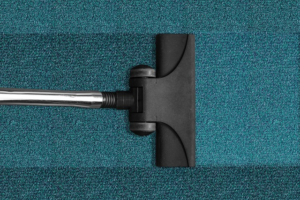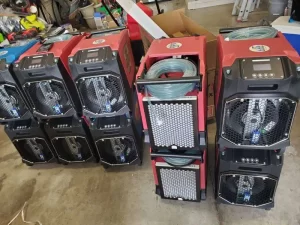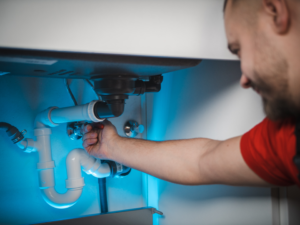What To Do When Sewage Backs Up Into Your Basement
One of the worst-case scenarios for a homeowner is when sewer lines backup in the basement. The sewer smells terrible, the water can damage the home’s structure, possessions can be ruined, and contaminants can enter the air and make flooded basements dangerous.
A sewage backup problem needs to be dealt with quickly and effectively to make the home safe again. The best action is to contact sewage cleanup professionals like Flood Kings who can give you an accurate estimate, document the damage for insurance claims, and complete effective repairs.
Potential Causes of a Sewage Backup
Before we get into the solutions for sewage backups, let’s talk about what can cause the main sewer line (sewer lateral) or drain pipes to force sewage water back into the home.
Clogs
The main culprit of a sewage backup is typically clogged drains or a blockage in the main sewer line. Clogs can form because of a buildup of grease, hair, food, paper towels, or other solid waste that prevents the flow of water. If a basement floor drain starts to slow down or a shower drain isn’t working properly, there is likely a clog which could cause a backup in the basement in the future.
Damaged Sewer Lines
Aging sewage systems often experience corrosion or rust that compromises their structure, especially if made from cast-iron or clay piping. These materials do not have long shelf lives, so normal wear and tear could cause damage that results in a basement floor drain backing up.
Tree Roots
Invasive tree roots are often the cause of a compromised sewer lateral line buried in the ground. Over time, these tree roots could grow into the pipes, causing holes, breaks, or squeezes that affect water flow. It is also difficult to prevent tree roots from affecting sewer lines and causing a sewer backup in your basement.
Heavy Rain
Sometimes, the source of a basement sewage backup has nothing to do with your own sewer line system. If the city sewer system cannot handle heavy rain or flooding, then a blockage or backup in the city sewer line could end up causing a sewer backup in the basement of a residential property.
Signs of a Sewer Backup
A quick cleanup process is the key to preventing long-term damage in your home from a sewage backup. But you cannot deal with the problem if you don’t know it is there. Watching out for the signs of a basement sewer backup can help you identify the issue quickly and plan a fast response. These signs include:
- Bad odors from the drains
- Bubbling toilets/drains
- Standing water from basement flooding
- Water overflowing sewer cleanout pipe
- Problems with faucets or other plumbing fixtures
- Slow draining
What to do Immediately After a Sewer Backup
The steps you take immediately after discovering a sewage backup are critical to an effective restoration project.
Clear Out of the Basement
Sewage backups are classified as black water damage. This is the most harmful of the three categories of water damage because it contains the most dangerous chemicals. Even if you do not come into physical contact with the sewage backup water, contaminants will still be in the air. Evacuate the basement to protect your health.
Call a Professional Restoration Company
Firms like Flood Kings exist to handle the water damage jobs that you cannot. The cost of a poor repair job could be permanent damage to the home or even a dangerous environment for your family. Professional contractors, on the other hand, tend to have more success with returning properties to their pre-loss conditions.
Open Up the Home
Ventilation is going to be key in this situation, especially in dealing with the bad odor and air quality in the home. If possible, open up the windows and doors to maximize airflow in the home.
Turn Off the Power
If it is safe to do so, you should try to shut off the power in the affected area. Water mixing with electricity could cause severe shocks or even a fire, so cutting power to the area that is flooded can prevent further disasters or injuries.
Wear Protective Gear
To protect yourself from the contaminants in the water and on surfaces after a sewage backup, wear boots, gloves, a mask, and even protective goggles to guard against health risks.
Shut Off the Water
The main shutoff valve for the water supply in your home is usually located in the basement. Turning off this valve can prevent more water from flooding the basement during a sewage backup. Stopping the source is the best way to mitigate further damage from occurring.
Notify Your Insurance Carrier and Municipal Authority
Now it is time to start considering how to move forward with handling the sewage backup. Contact your insurance company to notify them of the sewage backup and figure out what may be covered under your homeowners’ insurance policy. Additionally, if your home is connected to a public sewer line, then you should contact the sewer department or relevant municipal authority.
Stop Using Water Supply
Using the water in your home may only exacerbate the problem during a sewage backup. It is better to avoid using any of the faucets, showers, or toilets at this time.
Slow Down Spread of Germs
Sewer backups spread a lot of chemicals and bacteria in the home. You can slow down this spread before the cleaning process by placing chlorine bleach or baking soda in the standing water in the basement floor. This will start to disinfect the area and mitigate the spread of chemicals.
Clean the Flooded Basement
The cleaning process for a sewage backup must be thorough. After all, the affected surfaces may be infested with dangerous contaminants, and the air quality must be restored. If you are overwhelmed by the level of the damage, don’t hesitate to contact professional services with the equipment and knowledge needed to do the job right.
Often, the root cause of the sewage backup is beyond your capabilities to handle, so work with whatever contractor you need to address the problem.
Cleaning and Disinfecting When Sewer Lines Backup in the Basement
If you plan to tackle the flooded area yourself, then the following tips should help you complete an effective cleanup to return the basement to its pre-incident condition.
Safety First
Before you get started, prioritize your own safety and the safety of others in the home. Seal off the basement by closing the door so that you do not track any contaminated debris around the house. Put on protective clothing and gear like masks, gloves, goggles, boots, and anything else that will protect your skin.
Drain the Water
Clear the flooded area of standing water by draining the basement. You can do this with a sump pump, buckets, a wet vacuum, or other tools that can remove large volumes of water. If the sump basin is filled and doesn’t appear to be draining quickly, there could also be a problem with the sump pump, which may have been prevented by filter fabric or by placing it on a steady, flat brick.
Remember, if you cannot fix the source of the sewage backup yourself, call a professional that will have the equipment needed for effective draining.
Clear Debris and Belongings
Anything that came into contact with sewer water should be taken out of the room if possible. This includes belongings that must be thrown away, possessions that you can salvage, and debris like sludge. Use a shovel or broom to collect this sewage water debris and place it into thick plastic bags for disposal.
Do NOT touch these materials with your hands directly. Bag up any items that you want to clean later.
Disinfect Flooring/Walls
Any surfaces that came into contact with sewage water will need to be sanitized. You can make a simple cleaning solution using one cup of chlorine bleach and a gallon of warm water. This powerful cleaning agent can ensure that the chemicals and bacteria left behind by the sewer backup water are removed completely from the area.
Remove Unsalvageable Flooring
In many cases, your flooring may be ruined completely by the sewage backup water. Vinyl, wood, carpet, and carpet padding may need to be removed and thrown away completely. Don’t worry, Flood Kings can help you install new materials.
Scrub and Sanitize What Remains
If there are any remaining surfaces left to be cleaned, such as floors, steps, and walls, scrub them thoroughly with hot water and low-sud detergent. Sanitize these surfaces further with a bleach or baking soda solution.
Dry Out the Basement
Now you can start drying out the remaining wet materials. Whatever was missed by the wet vacuum or sump pump will have to be air-dried. To do this, open up any windows for fresh air circulation in the basement, turn on large air movers or fans, and turn on a dehumidifier to pull water droplets out of the air.
Drying can take a couple of days, so be prepared to have these machines running for a while. The more moisture you remove from the surfaces in the basement, the lower the chance of long-term damage.
Inspect for Mold and Monitor
Mold is a common symptom of all types of water damage, including sewage backups. Mold and mildew thrive in dark, damp spaces, and previously flooded basements are perfect environments. Inspect the area for mold in the coming days and weeks and get in touch with a mold remediation service if you find an infestation where you cannot reach it or clear it yourself.
Additionally, keep an eye on the basement and nearby rooms for other signs of water damage like musty smells, water stains, peeling paint, or sagging structural materials. These indicators might mean that water from the sewage backup was left behind.
Preventing Future Sewer Line Clogs
You likely never want to experience a sewer backup in your lifetime. The aftermath left your home messy and smelly, and the cost to repair the issue may have been very high. Fortunately, there are many strategies you can employ to avoid this problem in the future.
Dispose of Paper Products Correctly
Clogged drainage pipes are often the result of paper products being improperly disposed of either by flushing down the toilet or passing through a basement drain.
Make sure that items like diapers, tissues, paper towels, and feminine products are placed in the trash where they belong and not pushed through the home’s drain pipes.
Do Not Pour Grease into the Kitchen Sink
Grease, cooking oil, and other substances used during cooking are often poured down the kitchen sink for disposal. Even in liquid form, these substances can build up in connected sewer lines in the home, causing a sewage backup in your basement.
Keep your drainage and sewer lines clear by disposing of cooking oil and grease in the garbage.
Install a Backwater Prevention Valve
Backwater valves are a preventative measure that can reduce the chance of sewer backups by providing an additional outlet. Backwater valves can be installed in the main sewer line or basement drain line in the basement.
Replace Old Cast-Iron or Clay Piping
If you know that your main sewer line that is buried in the ground is old, then you may want to consider replacing it with a new plastic pipe. The older it is, the more likely it is to have corroded or worn away, which could cause sewer lines to back up in the future.
A new plastic pipe could increase the lifetime of this sewer line buried in the ground and reduce the chances of sewage backups.
Cut Tree Roots Near the Main Sewer Line
While it is not easy to prevent tree roots from affecting your sewer lines completely, you can take steps to lower the risk. Cut back tree roots that are growing close to the location of the underground sewer line to mitigate the chances of overgrowth compromising the structure of the pipe.
Maintain Your Sump Pump
Sewage backups often become worse due to a failed sump pump. Maintaining this crucial piece of machinery could prevent the damage from spreading too far in case of a backup in the basement.
Adding filter fabric to the basin gradually stops debris to allow for better operation, as well as placing it on a steady, flat brick.
Keep an Eye on Drains
Making sure that the floor drains, drain tubs, and basement drains in your home are functioning properly can lower the chances of a basement floor backup. A basement floor drain backing up is one of the most common causes of sewage backups, so it is important to ensure these drains are clear of blockages.
Use a drain snake if you notice that your basement floor drain backs up or if another drain line in the home is slowing down.
Flood Kings Can Help with a Sewage Backup in Your Basement
Whether you are dealing with damaged sewer lines, a slow-moving basement drain line, a problem when you flush toilets, or a completely ruined basement, Flood Kings can help return your basement to normal after a sewage disaster occurs.
Contact our emergency services 24/7 at 615-477-9968 and we will get a team out quickly to assess the problem and create a plan for addressing the issue and cleaning up your home. A fast response is critical to solving the backup in your basement.








